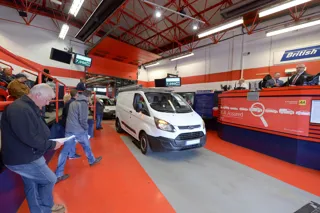As uncertainty rages in Westminster it spells good news for one sector of the industry. By Dean Bowkett
After two successive months of decline, new light commercial vehicle (LCV) sales enjoyed something of a recovery in August with total sales up 5.0% to 16,394 units, although they have since fallen by 6.14% in September.
The 2.5t to 3.5t range remain the biggest LCV segment, representing 61.6% of new van sales for the year-to-date (YTD). The 14.6% increase in sales in this segment in August helped offset the bulk of the 23.7% fall in sales of new vans under 2.5t during the month.
The August rally was not enough to offset the overall decline for the YTD, however, with new LCV sales still down 2.2% with just four months remaining.
Among the other commercial vehicle (CV) segments, pick-ups are up 3.5% with total sales of 32,686 this year. 4x4s have risen a dramatic 247.3% but this still represents just 1,080 units over the eight-month period.
At the heavy end of the new CV market – rigids between 3.5t and 6.0t – sales have topped 5,997 units by the end of August a 31.4% increase.
Fleet operators are growing increasingly concerned by political infighting and a lack of appreciation of how a no-deal Brexit will affect UK Plc.
Brexit, or more precisely the political rhetoric and posturing around Brexit, seems to be turning it into a conflagration, causing confusion for large and small businesses alike.
After an apparent softening of the messages coming from the EU a couple of months ago we have now seen an abrupt hardening of their approach, putting the Chequers deal up in flames as negotiations appear to be at an all-time low.
The domestic fighting between UK politicians makes it even harder for businesses to plan their fleet strategy.
Fleet operators are growing increasingly concerned by political infighting and a lack of appreciation of how a no-deal Brexit will affect UK Plc.
We can also point to a secondary fire burning – clean air zones (CAZs) are being introduced across the UK with little in the way of consistency.
Reluctant to invest
While our politicians in Westminster and town halls appear to to be doing their best to emulate Emperor Nero, fiddling as Rome burns, businesses need to keep the wheels of their fleets turning. While they are reluctant to invest in new LCVs the used LCVs continue to be on fire – but in a positive way!
Andy Picton, chief commercial vehicle editor of Glass’s, reported used traders heading back into the halls in strong numbers following the drop-off in July when the holiday season started.
According to Picton, sales were up 9.2% in August over the previous month and 1.5% up over the same time last year.
A month later, Cap HPI saw sales in September down 17.5% versus August but it believes this to be driven more by lack of stock than falling demand. What is clear from both trade guides is that the seasonal summer holiday fall in sales demand and prices seems to be a thing of the past with buyers able to bid even if sat by the poolside.
Matthew Davock, head of LCV at Manheim, noted that 78% of the stock offered received an online bid.
While buyers may be able to bid even when away, the same cannot be said for those preparing the used vehicles for sale.
"Buyers seem reluctant to invest in low specification and damaged vehicles" Andy Picton
Cap HPI points out that both refurbishment operations and logistics firms typically run to near full capacity and staff holidays will disrupt the flow of supply. This resulted in a 14% fall in auction entries in September versus August, Cap HPI highlighted.
When supply becomes constrained but demand remains high then conversion rates also normally improve and Manheim confirmed this, reporting a 5% improvement in first-time conversion rates compared to the same period last year.
Overall, first-time conversions were 78.8% at Manheim with an average of just 18.3 days to sell.
Demand is currently so strong buyers seem reluctant to invest in low specification and damaged vehicles with Picton noting a “focus on damage and specification and will pay more for the cleanest and straightest stock”.
Air conditioning also remains popular in the used van market but Glass’s noted that volumes of new Dispatch and Expert vans coming from the daily rental sectors are missing this desirable option, which may be costing the sellers.

Decent margins
Premiums are particularly strong for Euro 6 vans due to the aforementioned CAZs, as buyers try to ensure they cover all their bases. By buying clean and well-specified vans, dealers and traders are able to quickly get the vehicles on their websites and forecourts, enabling them to turn them over quickly – making decent margins in the process.
The demand for tidy and well-specified LCVs is not limited to the ex-fleet vans, with even those in the 2006-2010 range being snapped up by trade buyers, according to Picton.
Manheim identified a 20% increase in 4x4s in volume terms with the bulk being Ford, Nissan and Toyota.
Unlike the new van market, smaller used vans such as the Transit Connect and Mercedes-Benz Citan are doing well, with Glass’s noting average sales prices “increasing by more than £500 over the last year”.
While 4x4s have remained strong in the new van market, in the used van market there are reports of a general oversupply, although Glass’s did note that those with automatic transmission and plenty of options have been popular. Manheim identified a 20% increase in 4x4s in volume terms with the bulk being Ford, Nissan and Toyota.
With overall strong demand and supply limited, prices are continuing to rise. Cap HPI reported average prices of small vans improving by 1.3% with large vans rising by 1.8%.
Manheim also reported prices soaring with the average selling price for all vans in August 19% higher than the previous year at £6,424 despite the average age (57.9 months) and mileage (71,648) remaining steady.
Prices continue to break year-on-year records at BCA which reported average sales prices up 11.8% to £7,180 in August, although this was marginally down on the £7,221 achieved in July.
Like Manheim, BCA also saw age and mileage remaining relatively stable, with an average age of 50.95 months in August 2018, an increase of just 0.9%, while mileage increased from 65,273 in August 2017 to 66,880 for the same month this year.
Shoreham Vehicle Auctions managing director Alex Wright summed up the situation by stating: “Brexit is not likely to affect the used van market as small businesses must still invest in a van for their work. The used van market is always less volatile than the car market and we are likely to see strong used prices continuing well into the future.”
However, Davock sees the combined impact of the worldwide harmonised light vehicle test procedure (WLTP) and CAZ resulting in “super-heated” demand for Euro 6.
In summary, it seems as if fires are raging all around the world of LCVs, some good and some severe. But until our political leaders start getting some of the fires under control, it is the used van market that remains the hottest.



















Login to comment
Comments
No comments have been made yet.